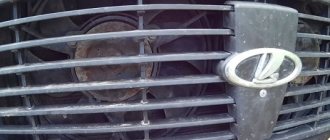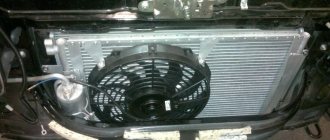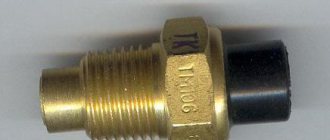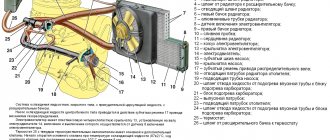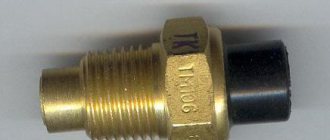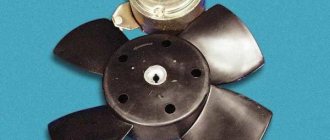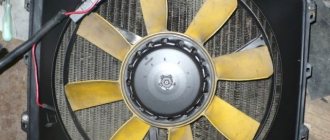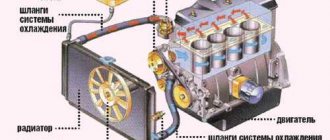We reveal such a problem on a NIVA car as non-working (not turning on) radiator cooling fans. What could be the reasons? The first thing you need to do is check the fuses; they can be changed in a couple of minutes.
The fuses are located here:
It's 30 amp. We take them out and check them for integrity. If the fuses are blown, there are several reasons for this that will need to be corrected, otherwise they will continue to burn.
One of the reasons is that the fans are wedged, the fuses cannot withstand the load and burn, the second reason is that the fuses are not 30 Amps, but 15 or 20, they are not designed for such a load and they burn. The third reason is these two plugs:
It happens that they become clogged with dirt, water, rust, short out, or melt. Very often they close up when overcoming water obstacles, then dry out and start working again.
The fourth reason is the rest of the wiring, you need to look along the entire length, look for fraying, melting, etc. We have listed everything that relates to fuses, let's move on.
Then pay attention to whether the fans are jammed, this can happen due to wear of the bearings, try to twist the blades, just do this not with your hands, but with a stick.
From this coolant temperature sensor, the controller reads information to turn on the fans:
If, for example, your radiator fans are constantly running and they never turn off, then most likely the problem is in this sensor.
We tried to write in text the most common reasons why the radiator fans on the NIV do not turn on or do not work, if this does not help you, watch the video below for more details, several more possible reasons are given there, and also tells how to emergency and force start radiators in the field.
More details about the problem of fans not working on Niva:
Published August 30, 2016
Checking the VAZ NIVA thermostat without removing it. Choosing a VAZ NIVA thermostat All signs of a broken cylinder head gasket on a VAZ NIVA. At all stages of head gasket failure
Signs of a pump malfunction. Choosing a VAZ pump. VAZ NIVA pump design. All reasons for engine overheating and boiling. Eliminating the causes of VAZ NIVA engine overheating
Details. Why the cooling fans of the NIVA VAZ radiator do not turn on. Ideal inclusion and operation of the VAZ NIVA fans. Radiator cooling fan switching temperature
Features of the Niva cooling system.
The VAZ-21214 engine cooling system is designed for off-road driving, that is, to operate for a long time at low speed and high revs.
This causes the engine to become very hot. Therefore, the Nivas are equipped with a cooling radiator slightly larger than on the classics and two cooling fans. In fact, the machines are operated mainly in urban environments, where the engine operates without overload and the operation of two fans to cool the radiator is practically not needed. In addition, when operating, the Niva cooling fan makes quite a bit of noise, which affects comfort.
Fans. Problems and solutions.
- Go to page:
Re: Fans. Problems and solutions.
Post by Axen » Jun 30, 2012, 02:20
Re: Fans. Problems and solutions.
Post by badull » 03 Aug 2012, 20:25
Re: Fans. Problems and solutions.
Post by Skrater » 03 Aug 2012, 20:33
Re: Fans. Problems and solutions.
Post by badull » 04 Aug 2012, 09:19
Re: Fans. Problems and solutions.
Post by Stranger21 » 04 Aug 2012, 10:46
Re: Fans. Problems and solutions.
Post by tester12 » 06 Aug 2012, 14:15
Re: Fans. Problems and solutions.
Post by tester12 » 06 Aug 2012, 14:16
Re: Fans. Problems and solutions.
Post by Alexsha » Aug 13, 2012, 02:23 pm
Maybe someone who has encountered such a problem can give some useful advice.
In short, the radiator cooling fans are not working. VAZ 21214 engineer And in detail it looks like this: the fuses are normal; electric motors are working (checked by connecting to the battery); if you measure the voltage at the disconnected connector, then 12V appears at the right moment (
110 gr.). But as soon as I connect the connector to the contacts of the electric motors, the voltage drops to zero! And the fans don't work. The wires have already been replaced right up to the entrance to the dashboard. A similar situation was with the low beam. But I quickly figured it out - I cleaned the contacts on the connector and that’s it
Description of the Niva fan circuit.
In the factory circuit, the fans are connected in parallel to each other, and switching on is carried out automatically through two relays. Automatic activation depends on the engine type. On a carburetor engine, activation is carried out by a sensor mounted on the radiator. The temperature in this case depends on the response temperature of the sensor indicated on the housing. On an injection engine, the fans are turned on by the engine control unit when the temperature recorded in the control program is reached.
How the fans on the Niva 21214 are turned on.
Niva cooling fan
- Fuel system
- Clutch and couplings
- Brake system The connection diagram for Niva VAZ-21214 fans is identical to the diagram for other cars of the VAZ family. The only difference is the presence of two fans, which are turned on using two relays. This is caused by the engine working under heavy loads when driving off-road.
In city conditions this is practically not necessary, with the possible exception of driving in traffic jams in hot weather.When turned on, fans create some discomfort as they make noise. You can reduce noise by reducing the rotation speed of the electric motors or turning off one of the fans. In the second case, the second fan can be turned on forcibly using a button or key. Methods for connecting fans. There are two ways to reduce the rotation speed of the fan motors.
The first is to connect an additional resistance of sufficient power in series with each fan motor. The second way is to connect Niva fans in series. The disadvantage in the first case is the search for resistance, which will also heat up.
In the second case, a minimum of alterations are required.
It is enough to pull out the negative wire from the connector of the first fan, and the positive wire from the second connector. After this, connect the free terminals on the motors with a wire of the appropriate cross-section.
But in this case, in order to turn on the fans at high speeds, you will need to redo everything back. If you want the fans to be able to operate at low and high speeds depending on the heating of the engine, then you will need to install an additional relay that will switch the fans from serial to parallel connection . This relay can be controlled manually or automatically. You can also combine both control methods.
The design of the Niva fan connection diagram can be different, depending on the type of engine and your preferences. For manual switching, you need to install a switch, a key is best, and for automatic
- Steering
- Transmission
- Suspension
- Exhaust system
Fan malfunctions
Let's look at what malfunctions of the Niva cooling fan may occur and how to identify them. The most common malfunction is blown fuses.
The fuse blows.
A single occurrence of such a malfunction does not indicate a faulty wiring or the fans themselves. During operation, fuses heat up and eventually fail. They are easy enough to replace. They are located on a carburetor car in the lower fuse block, and on an injection car in an additional block near the driver's door pillar.
If the fuses blow immediately when the fans are turned on, then it is necessary to find a short circuit or replace the fan. To determine the location of the malfunction, it is enough to disconnect the connector on the fan motor and connect the wires on the radiator sensor with each other with the ignition on.
On an injection engine, to check it is necessary to remove the chip from the temperature sensor, which is located on the thermostat. In this case, the engine control unit will go into emergency mode and activate a program for working with a faulty temperature sensor and turn on the fan relay. If the fuse burns out, then it is necessary to find and eliminate the short circuit. If the fuse remains intact, then the problem is most likely in the fan motor. Faulty fans are stuck or difficult to rotate. This may be caused by the stator magnet falling off or the armature bushings wearing out. A faulty fan should be replaced.
The fan does not turn on
Another common malfunction is when the fan does not turn on when the operating temperature is reached. The reason may be a malfunction of the fan sensor on a carburetor car or the engine control unit on an injection car, a relay malfunction, broken wires, or a malfunction of the fan motor.
It is better to start troubleshooting by checking the temperature sensor or control unit. This is done as described earlier by bridging the wires on the carburetor engine sensor or removing the chip from the temperature sensor on the injection engine. If the fans do not work, then you need to check the power relay.
The relays are located under the instrument panel on the front wall. To check, remove the chip from the relay and check for the presence of power at pins 30 and 85. If there is no power, check the condition of the fuse and wires. If there is power, connect terminals 86 and 85 of the relay with a test lamp. If the warning lamp does not light up, then the wire from the ECU connector to the relay socket is broken or the ECU itself is faulty. A lit lamp indicates a relay malfunction.
To test the relay, connect pins 87 and 30 with a piece of copper wire, which should trigger the fans. If this does not happen, then connect a test lamp to the connector without removing the jumper from the relay connector. If the lamp does not light up, then connect one end of the test lamp to the housing, and with the other, check for the presence of a plus on the connector. If the control lamp does not light up, then there is a break in the wire from the relay to the fan connector. Accordingly, the glow of the lamp indicates poor contact of the negative wire with the body or a wire break. The presence of power and minus indicates a malfunction of the electric motor.
If the fan starts working when the relay terminals are bridged, it is necessary to check the condition of the wires connecting the temperature sensor or the engine control unit, depending on the type of engine.
Source
Replacing fans
If the fan motors do not start when the wires from the battery are connected directly to the power terminals, the devices must be replaced.
To do this, you will need a set of wrenches ranging in size from 10 to 17 mm and a Phillips screwdriver.
Before starting work, you need to drive the car onto an inspection ditch or a lift and turn off the power to the on-board network by removing the negative terminal of the battery.
Fans are dismantled as follows:
- Remove the crankcase protection and mud guard.
- Unscrew the screws and remove the thick spider-shaped plate and a couple of tin covers that are located in front under the bottom of the car.
- Unscrew the radiator frame cross member.
- Loosen the tension and remove the power steering belt and pump.
- Remove the 4 bolts holding the power steering pump.
Useful video showing how to remove and change fans:
Important: to get to the bolt covered by the oil filter, you need to move the amplifier away from the bracket.
- Push the pump back, hanging it on the hoses.
- Remove the air conditioner drive belt.
- Remove the bolt holding the timing belt pulley.
- Remove the pulley and belt.
- Unscrew the four nuts at the corners of the electric fan housing and the two bolts securing it in the middle.
- Remove the fan unit from the studs and pull it down.
Tip: The crankshaft position sensor makes it difficult to remove the fans. Therefore, they need to be pulled out gradually. The left side is lowered first, then the block is moved to the left, raising the right edge so that the casing becomes vertical.
This method is probably suitable for restyled Niva Chevrolet models. On older cars, you will have to remove the radiator grille and bumper, unscrew the fasteners and move the air conditioning and cooling radiators forward. After this, access to the electric fans will be open.
During dismantling, you should carefully remember the procedure. Assembly is carried out in reverse order.
Important: the service life of the fan motors is approximately the same. Therefore, even if one of them fails, both must be replaced. Otherwise, you will soon have to repair the car again.
System structure and principle of turning on fans
Everything works as follows.
- The radiator and engine block are looped into a single system using pipes. Between them there is a rheostat - a damper with a temperature-sensitive element inside.
- When a certain temperature is reached, the damper opens and the liquid begins to circulate in a large circle.
- If passive cooling fails, the engine temperature rises. The head cooling fans come into play. When the temperature limit is overcome, the DTOZh sends an impulse to the BC.
- The processed signal closes the relay and the fan turns on. To improve system performance, the devices are paired. Dubbing helps prevent overheating if one of the devices breaks down. At the same time, the connection diagram for active coolers implies their simultaneous and separate activation.
Heating and ventilation system. VAZ 21213, 21214 (Niva)
The cooling system is liquid, closed type, with forced circulation. The tightness of the system is ensured by valves in the expansion tank plug. The inlet valve is normally open (the gap between it and the rubber gasket is 0.5–1.1 mm) - in this case, the system communicates with the expansion tank. When the engine heats up, the liquid expands and is forced into the tank; when it cools, it returns back. The inlet valve closes when there is a sharp increase in pressure in the system (boiling liquid), while the outlet valve is also closed. It opens when the pressure in the system reaches approximately 0.5 kgf/cm2, which increases the boiling point of the liquid and reduces its losses. The thermal operating conditions of the engine are maintained by a thermostat and a radiator fan. On a carburetor engine, the fan is mechanically driven and mounted on the coolant pump pulley. On an engine equipped with an injection system, two electric fans are installed in front of the radiator and are activated by command from the electronic engine control unit.
Injection engine cooling system
The coolant pump is a vane, centrifugal type, driven from the crankshaft pulley by a V-belt. The pump housing is aluminum. The roller rotates in a double-row bearing with a lifetime supply of lubricant. The outer ring of the bearing is locked with a screw. A pulley hub is pressed onto the front end of the roller, and a plastic impeller is pressed onto the rear end. For the correct position of the pump pulley groove, the distance from the mating surface of the pump cover to the outer end of the hub must be 84.4 ± 0.1 mm. When installing the cover with the gasket, check the gap of 0.9–1.3 mm between the impeller blades and the pump housing. To do this, you can use plasticine rollers: they are placed on equidistant impeller blades, a cover is installed, the nuts securing it are tightened, then the cover is removed and the remaining thickness of the plasticine is measured - it is equal to the gap.
Axial and radial play in the pump bearing that can be felt by hand is not allowed. If the bearing or self-pressing seal of the pump fails, it is recommended to replace the pump cover complete with the roller and impeller.
The redistribution of liquid flows is controlled by a thermostat with a solid heat-sensitive element. On a cold engine, the thermostat valve closes the pipe leading to the radiator, and the liquid circulates only in a small circle (through the thermostat bypass pipe), bypassing the radiator. The small circle includes the heater radiator, intake manifold, carburetor heating unit (on engine 21213) or throttle assembly (on engine 21214). At a temperature of 78–85°C, the valve begins to move, opening the main pipe; in this case, part of the liquid circulates in a large circle through the radiator. At a temperature of about 90°C, the main valve opens completely, and the bypass valve closes, and all the liquid circulates through the engine radiator. The main valve stroke must be at least 6.0 mm.
You can evaluate the serviceability of the thermostat by heating the lower radiator pipe: it should be cold until the liquid temperature (according to the indicator) reaches 80–85°C, and hot when it rises to 85–90°C. The thermostat is beyond repair. In case of malfunction, loss of tightness, or deformation of the pipes, it is replaced.
The radiator consists of two vertical plastic tanks (the left one has a baffle) and two horizontal rows of round aluminum tubes with pressed-on cooling plates. To increase cooling efficiency, the plates are stamped with a notch. The tubes are connected to the tanks through a rubber gasket. The liquid is supplied through the upper pipe and discharged through the lower. There is a coolant drain plug at the bottom of the left reservoir.
For better radiator airflow, casings are designed to direct air flow from the fan(s).
On the 21213 engine, the main fan shroud consists of two halves (lower and upper), the lower half has a rubber seal on the radiator side. An additional guide casing is installed in front of the radiator. On the 21214 engine, electric fans rotate in a casing in front of the radiator.
The expansion tank is made of translucent polyethylene, which allows you to visually monitor the fluid level (3–5 cm above the “MIN” mark on a cold engine).
To monitor the coolant temperature, a sensor is screwed into the engine cylinder head and is connected to a temperature gauge on the dashboard. An additional temperature sensor is installed in the exhaust pipe of the 21214 engine, which provides information to the electronic engine control unit (see here).
Cooling fan Niva 21214 does not turn off.
Connecting Niva fans
The lifespan of a Niva SUV engine largely depends on how efficiently the VAZ-2121 cooling works. After all, overheating is the first enemy leading to expensive repairs.
This is why the serviceability of the components and elements of the cooling circuit is so important. In order to be able to service them and identify malfunctions, you need to understand what the circuit consists of and how the Niva’s cooling functions. The cooling system of the VAZ Niva is quite effective and has undergone virtually no changes since its creation.
It includes the following units and elements:
- Cooling radiator with 2 plastic tanks on the sides. Located at the front of the car.
- Mechanical water pump (pump). Installed in the cylinder block on the front side, its impeller is immersed in coolant circulating through the water jacket of the VAZ-2121 engine. Driven by belt drive.
- Fan with air diffuser. Attached to the inside of the radiator.
- Expansion plastic tank with a lid equipped with valves. Connected by a pipe to the radiator.
- Mechanical thermostatic element (thermostat). Located from the block in the direction of travel. From it the pipes go to the water jacket and radiator.
- Interior heater heat exchanger equipped with a tap.
Temperature control in the Niva engine cooling network is carried out. In the carburetor model VAZ-21213, a sensor is built into the cylinder head, connected to the temperature indicator on the dashboard. On the VAZ-21214 model, where the fuel is supplied by an injector, there is a second sensor mounted in the pipe on the cylinder head.
It is connected to a controller that cooks depending on the heating of the power unit and turns on the fans. There are 2 more differences in the cooling design of engines with a carburetor and an injector:
- The heating pipes for the lower part of the carburetor in model 21214 provide heating for the throttle body.
- on cars with direct fuel injection, there are 2 installed on the radiator instead of 1 mechanical;
In VAZ-2131 cars, the cooling system is generally similar to a regular Niva with an injector.
The VAZ-2131 heater radiator is not equipped with a tap, which is why antifreeze flows through it all year round. The Niva's cooling circuit operates under pressure, since in normal mode it does not communicate with the atmosphere.
The coolant is antifreeze with a freezing point of -40 °C. It is a solution of water with ethylene glycol, the amount to fill the system is 10.7 liters.
It also boils at an elevated temperature, +110 °C. The key element in the operation of the system is the thermostatic valve, which distributes fluid flows depending on the heating of the engine. Inside the thermostat there is a damper controlled by a temperature-sensitive element.
When heated, it moves the damper, opening another path for the flow. In general, the scheme works according to the following algorithm:
- When the engine is not warmed up to operating temperature (90 ° C), antifreeze, stimulated by the pump, circulates through a small cooling circuit: engine, thermostat, interior heater radiator.
The cooling fan turns on on a cold engine: the main reasons and solution to the problem
As you know, various malfunctions do not allow the motor to reach the optimal temperature regime. The engine may overheat, which can lead to rapid breakdown, or remain cold, that is, not run.
Modern cars use a combined cooling system: liquid and air cooling.
By liquid we should understand circulation through special channels in and around the engine.
The coolant circulates thanks to the pump (). For additional cooling, the coolant can also circulate in a small circle (inside the engine) and in a large circle, that is, through. Air cooling is implemented using a fan, which removes excess heat by supplying an air flow into the engine compartment to blow over the engine.
The specified fan is activated when the heating of the unit is sufficiently high. However, quite often drivers are faced with the question of why the cooling fan turns on on a cold engine, the engine fan turns on in winter or spins constantly. In this article we will talk about the reasons why the cooling fan operates on a cold engine, the engine cooling fan does not turn off, or the specified fan does not work correctly.
Let's start with the fact that this problem can clearly indicate both a malfunction of the liquid cooling system and a malfunction of the fan itself. In any case, we are talking about a breakdown that cannot be ignored, since the risk of overheating of the internal combustion engine significantly increases. For a better understanding, it is necessary to superficially consider the principle of operation of the fan on most modern cars.
The airflow is activated by a special sensor located at the bottom of the radiator. Also, many cars use a separate engine cooling fan control unit. There are also models in which the fan itself is responsible for turning on the fan, but this design is rarely used.
So, after heating the coolant to an average temperature of about 100 degrees Celsius, the sensor or control unit closes the electrical circuit. After this, the fan turns on, improving engine cooling. When the coolant temperature drops to the required value, the circuit opens and the blowing stops.
As you can see, the fan should not work on a cold engine. So, to determine why the fan turns on early, for injection machines it is recommended to start with. The fact is that the ability to read error codes from the ECU allows you to more accurately determine the cause of the malfunction.
We also note that in cases where the control unit detects errors in the cooling system, the fan can spin immediately after turning on the ignition, even on a cold internal combustion engine.
This feature is found only on some models and is, in fact, protection against overheating of the power unit, since a constantly running fan reduces the temperature. After repairs, in this case it will also be necessary to carry out.
To erase an error from the ECU, on some models it is enough to remove the terminal from the battery for a couple of minutes, while on others the reset is carried out using diagnostic equipment.
Purpose and design
This is a module designed to be included in the on-board circuit of a motor that consumes high current. The fan motor is powered by electricity with a current of 20-35A, which is unacceptable for inclusion in a low-voltage control system - the wiring will melt. The Niva has only three relays, two for the left and right fans separately and one common. Each device has its own number in the on-board network. The principle of operation and purpose of the relay is relevant for cars of all types 2004, 2010, 2022 and other years of production.
Inside, the relays have an identical design. There is a low part, a transformer and a high part. Also two pairs of contacts, one normally closed, the second open. When a pulse is applied to the lower part, a magnetic field is formed on the windings, and the contact group on the high side closes - power is supplied to the fan motor.
The cooling screw operates in two modes. When the engine heats up to 99 degrees Celsius, the first fan is turned on, after passing the 101⁰C mark, the second one is connected. If the system cannot cope, the motors switch to higher speeds.
Fan relay diagram
The figure shows the power supply circuit for the electric fans of the cooling system of the installation. Design elements are presented by numbers.
- 1/7 – left and right fan motors;
- 2 – additional power relay;
- 3 – fuse;
- 4 – power controller;
- 5 – auxiliary resistor;
- 6/8 – main relay for turning on the right and left electric motor, respectively;
- A/C – negative/positive battery terminal;
- B – to the main ignition relay.
Niva Chevrolet: engine cooling fan relay
Everyone knows that modern cars have a water engine cooling system in their design, which allows many times to increase the service life of not only the engine, but also the entire mechanism as a whole. The Chevrolet Niva also has a radiator in its design that is filled with coolant. This liquid circulates through the system, thereby cooling the car engine. But the engine temperature exceeds 100 degrees, so if this liquid is not cooled, it will soon turn from cooling to heating. This is precisely why there is a radiator cooling system, the operation of which is carried out by a fan. But since the Chevrolet Niva is equipped with a powerful 1.7-liter engine, two fans are used to cool the radiator. In this article, we will look at how these devices work, or rather, what is the main element of turning on these devices on a Chevrolet Niva SUV.
Fan switching principle
The cooling fan is powered by a constant voltage of 12 V from the battery. They turn on when two sensors located in the engine reach a certain temperature. So, when the first sensor reaches a temperature of 99 degrees Celsius, it is triggered, which causes the first fan to turn on. It has two rotation speed positions - high and low rotation speeds. When the second sensor reaches a value of 101 degrees, then, accordingly, the second device turns on. Thus, the cooling devices of the Chevrolet Niva engine are briefly activated. But we are interested in what role such a small device as a relay, of which there are three on the Chevrolet Niva, plays in this process.
A universal scanner for self-diagnosis of any car.
Relay purpose and design
The relay is designed for switching large load currents. This is a rather complex formulation, so in simple terms, a relay is necessary in order to be able to control electrical circuits where there are large currents. The electric motor of the cooler consumes direct current, the value of which is 20-30 amperes, which means that if it is included in the control circuit (where small currents pass), then all the electronics will fail (the wiring will melt). That is why such an important control element is installed in the design of cars.
Externally, the product is a plastic base, inside of which the mechanism itself is located. There are five (four) contacts on the back side of the base. They are the basis for including a relay in the control circuit.
Inside, the relay mechanism is presented in the form of a coil with a core - it is also the basis for closing the circuit contacts. In the photo below you can see the appearance of the Chevrolet Niva product.
Niva 21214 malfunction fan constantly running
Azat Galiev Hello Andrey encountered the following problem: the left fan (on the driver’s side) does not turn on; the screw connected directly is fine, but the right one turns on at 100+, what could be the problem? matte 159 rus Hello, forgive me for contacting me so often for some reason at one point 1 fan did not turn off and continued to work for 30 minutes, I turned off the car, removed the terminal, it still did not turn off, and when I turned it off, it continued to work, while the terminal was turning it off, I pulled out a fuse it stalled, then waited for about 15 minutes, inserted the fuse, the fan started working again, turned the ignition key, the fan stopped working, didn’t understand anything, drove on with the “NIVA URBAN” (for sale if anything :).) Hello. Thank you very much for your work! For me, as a beginner nivavodka, this is invaluable knowledge.
Important If insulation is installed, the engine will not be able to cool effectively.
This may be the answer to the question of why the radiator cooling fan is constantly running. But this is a fairly rare reason.
So, among the most popular reasons why a fan is unstable are problems with electronics. This is exactly what most car owners complain about on specialized forums.
Many solve this problem by replacing the sensor and fuses. And it helps. In half of the cases, the issue can be resolved by replacing the thermostat.
Info The situation can also be improved by cleaning the radiator.
Problems happen on any car; this topic worries Ford Focus car owners. The cooling fan runs constantly on luxury cars as well.
It is important to notice this problem in time, otherwise it can lead to disastrous consequences.
This feature is found only on some models and is, in fact, protection against overheating of the power unit, since a constantly running fan reduces the temperature.
After repair, in this case you will also need to reset the errors. To erase an error from the ECU, on some models it is enough to remove the terminal from the battery for a couple of minutes, while on others the reset is carried out using diagnostic equipment.
Now let's look at common problems that are associated with the cooling system and the fan itself.
- First of all, in many cases the contacts of the air system sensor short-circuit.
The engine may overheat, which can lead to rapid breakdown, or remain cold, that is, not reach operating temperature.
Modern cars use a combined internal combustion engine cooling system: liquid and air cooling.
By liquid we mean the circulation of antifreeze or antifreeze through special channels in the cylinder block and cylinder head of the engine.
The coolant circulates thanks to a pump.
For additional cooling, the coolant can also circulate in a small circle (inside the engine) and in a large circle, that is, through the radiator. However, quite often drivers are faced with the question of why the cooling fan turns on on a cold engine, the engine fan turns on in winter or spins constantly.
Job
The Shniva cooling system has two active cooling elements. There is a fan for the heater radiator and the main heat exchanger. The following information is relevant for cars of 2010 and other model years.
Fuses are responsible for the correct, stable operation of devices. Fuse links will protect the device from power surges and short circuits.
Pulley fan fuse: where is it located?
Located in close proximity to the corresponding relays. The stove insert is located in the main mounting block under number F18. A 25 amp fuse protects multiple circuits at once.
Possible malfunctions and their causes
If the fans do not turn on on time, the problem may be hiding in the following places.
- Relays or fuses have blown.
- DTOZH does not work correctly.
- The wiring of the device is damaged.
- Incorrect ECU settings.
- The fan motor is damaged or shorted.
Checking the functionality of the sensor, relays and fuses
The DTOZH is responsible for the operation of the fans; it is easy to check.
- Prepare a thermometer, multimeter, kettle or bowl of cool water.
- Immerse the sensor in a container and put it on fire, at the same time immerse the thermometer in water.
- When passing thresholds of 5 degrees, you should connect the multimeter to the sensor in resistance mode. At the same time, record the data.
- After heating the water to a boil, take the last measurements and compare the results with the reference table below. If the device indicators differ by more than 10% from the standard, the sensor is changed.
Forced activation of cooling fans
To make this possible, car enthusiasts install an additional switch into the device circuit and power it directly from the battery. The operation of the electronics is disrupted and the on-board computer may generate an error.
To fake the device, users on the network recommend using a scheme.
A relay and a forced switch are added here.
Replacing the Fan Relay
Due to the simplicity of the design, the procedure is performed according to a standard scenario. Access to the mounting block is opened, the terminal of the relay contact group is disconnected. Next, the device is unscrewed from the panel and replaced with a new one.
The cooling fan of the VAZ 21214 often turns on.
Niva cooling fan
Radiator cooling fans VAZ NIVA. Fan switching temperature +95+98 degrees. The duration of operation of the fans depends on the temperature and condition (serviceability of all components) of the engine cooling system.
If the fans do not work normally for a long time, then, if necessary, you can find the reason. I talked about this in previous videos.
Links below in the description: How to remove VAZ NIVA.
Correctly removing the air lock of the VAZ NIVA Checking the thermostat of the VAZ NIVA without removing it. Choosing a VAZ NIVA thermostat All signs of a broken VAZ NIVA.
At all stages of head gasket failure Signs of a pump malfunction. Choosing a VAZ pump. VAZ NIVA pump design. All reasons for engine overheating and boiling.
Eliminating the causes of overheating of the VAZ NIVA engine in detail.
Why the cooling fans of the NIVA VAZ radiator do not turn on. Ideal inclusion and operation of the VAZ NIVA fans. Turn-on temperature for radiator cooling fans Comments Preemptive strike Andrey, do you have standard fans?
They don’t seem to buzz as loudly as our 2131.
When ours howls, you can hear it a kilometer away. True, judging by the dashboard, your car is older than ours (ours is 2013), but your fans are also electric and visually similar to those on our Niva. Have you encountered such a situation? Ruslan Rinatovich respect to the niva drivers) Alexander Bondarenko Oh, these fans are disgusting, they howl so that you immediately understand that somewhere in a traffic jam a Niva is driving, and how they attract the attention of the neighbors downstream.
They all howl the same way, it’s just that from the video it seems quieter. But this is the question I have in the M-ka 2014: when I fill up with fuel, the arrow does not reach the maximum when the tank is full, is this the case for everyone? Another question is when half or a quarter of the gasoline is filled, the smell of gasoline appears in the cabin, but it is not obvious, but with a full tank everything is normal and there are no odors. Kristina Shagazizova Niva21214 2000, Fans work without noise!!!
Why??? So what switch-on temperature is considered correct and safe for the engine. On the bookmaker you can set at least 90. max crap Thanks Andrey. Yesterday I tested the Niva off-road) the fans work, they turn on only when the needle approaches 130, and somehow quickly turn off, literally 40 seconds and that’s it.
When is the next video)? Andrey Lapochkin For +gruzchik79. Hello. The operating temperature is +90C, but the fans should be turned on according to the standard at +95+98C - this is for more complete combustion of fuel.
For materials, the safest engine temperature is generally +85C. Set it to +85C, only if your thermostat opens at +87C, then why should the fans turn on at +85? And +90C is too early. At 2112 at +101C it turns on and at 97-98 it turns off.
The fan switch-on temperature on the latest generation VAZ 2110 -2112 engines is generally (100-105 C). It is too high compared to the normal operating temperature of the engine (85-90 C). This innovation is related to the manufacturer’s struggle for cleaner exhaust from the pipe (requirements of modern Euro 3 standards and higher). At a given temperature, more fuel and its components occur, but the load on metal, plastic, rubber, wires is greater and, as a result, wear is faster.
Reasons why the cooling fan does not work on a Chevrolet Niva
To maintain the optimal temperature in the engine, a cooling system is installed in the car. One of the main elements in this system are fans, thanks to which the required amount of air is supplied to the engine through the radiator core. If it stops working, the Niva Chevrolet cooling fan overheats as excess heat begins to accumulate. Unlike classic cars, it has two fans, making the functioning of the systems much more complicated. If the arrow that shows the temperature is in the red area, and the cooling system refuses to work, and at the same time the cooling fan does not turn on, then the car should be taken to a car service center as quickly as possible, or you should try to find the cause of the malfunction yourself.
- 1 Causes of malfunction
- 2 Checking and removing fans
Causes of malfunction
The first thing you should pay attention to when the system is not working is the state of the fuses, which are located under the front panel, on the passenger side, in a special mounting block. A pair of fuses are responsible for the cooling operation; if the right one fails, then both fans stop working, and if the left fuse blows, then one element can continue to operate.
In addition, the mounting block has three relays that are responsible for operating the fans at different speeds. And if the relay responsible for operation at low speeds burns out, then the cooling system works correctly only at high speeds, and at low speeds the engine begins to heat up. Power is supplied to the relay through a special fuse, which can also fail, causing system failure.
Failure of temperature sensors also affects proper cooling operation. They are located on the engine. They operate when the desired temperature is reached, one when it reaches 90 degrees, and the second when it reaches 101 degrees. It is recommended to start checking with them, this is done this way: the connector is disconnected from the electric motor, and power is supplied to them directly through the battery; if the electric motor is running, then the reason is in the sensors.
Source
What to do if the fan does not work?
So, while driving the car, it was noted that the temperature had reached a critical level, but the fan did not turn on. The vehicle should be stopped immediately and the engine allowed to cool. After which you can:
- Drive constantly at speeds above 60 km/h so that the liquid is cooled by a counter flow of air;
- Close the wires going to the sensor to enable forced operation of the fan;
- Turn on the cabin heating system at full power so that some of the heat from the liquid is transferred into the cabin;
These three methods will help you get to the nearest service station and home to fix the problem without any problems or engine overheating.
